Producer Ken Scott works hard at the mixing board circa 1968 while working on the Beatles’ White
Album at Abbey Road Studios. Photo courtesy of Ken Scott
It almost sounds like a feel-good Hollywood movie: A young man gets hired by Abbey Road Studios at age 16. After moving up through the ranks, his first session as an assistant engineer is A Hard Day’s Night by an English group known as The Beatles. That same young man’s debut session as first engineer is Magical Mystery Tour. He then works on the White Album and subsequently goes on to record seminal albums with the biggest artists from the ’60s, ’70s, ‘80s, and beyond—Jeff Beck, Dixie Dregs, Supertramp, Elton John, Missing Persons, John Lennon, George Harrison, The Tubes, Stanley Clarke, Mahavishnu Orchestra, Pink Floyd, Devo, Lou Reed, Kansas, Billy Cobham, David Bowie, and many, many more. Definitely a dream career, yet also the true-life story of record producer/ recording engineer, Ken Scott.
Along the way, Scott worked with a who’s who of guitarists: Beck, Steve Morse, John McLaughlin, Tommy Bolin, Mick Ronson, David Gilmour, George Harrison, Eric Clapton, just to name a few, as well as legendary drummers (Rod Morgenstein, Ringo Starr, Terry Bozzio), and bass players (Clarke, Andy West, Patrick O’Hearn). Along the way he earned a CLIO Award for recording “I’d Like to Buy the World a Coke” and two Grammy nominations, but has yet to win a Grammy.
Scott remains a vital force in the industry today, recording and producing, as well as releasing a virtual drum library, Epik Drums—A Ken Scott Collection, featuring five stellar drummers from his past, as well as Epik Drums EDU, a DVD set documenting his approach to recording and mixing drums. His latest effort is his just-released autobiography, Abbey Road to Ziggy Stardust. Ken generously gave Premier Guitar an extended interview in the middle of a long day of book promotion, discussing how he approaches making music as a producer, and, of course, his approach to recording all those killer guitarists.
You actually started your career at Abbey
Road Studios at age 16?
That is absolutely correct, yeah.
How did you land that job?
Someone upstairs was looking after me! I
got fed up with school. One Friday evening
I wrote letters to about 10 places.
All those letters were mailed on Saturday;
I heard back from EMI [parent company
of Abbey Road] on Tuesday, had an interview
on Wednesday, and was accepted on
Friday. I left school that day and started at
Abbey Road the following Monday. Like
I say, someone upstairs was looking after
me. [Laughs.]
What was your first job there?
Tape library—just getting tapes, checking
in tapes, and making sure they were in the
right cutting room or studio.
How did you move from that into the
engineering side of things?
Via second [assistant] engineering, doing
that for a few years. My very first session
as a second engineer was on side two of
A Hard Day’s Night and I carried on with
them [The Beatles] all the way through
to Rubber Soul. Then I was promoted to
mastering—disc cutting. EMI felt it was
better to learn the final product before you
worked on the “easy” side of it. So you
could never become an engineer without
knowing the problems that may ensue if
you don’t give the cutter a good tape. After
doing that for a few years, I got the phone
call to move downstairs as an engineer.
After sitting next to one of the other engineers
for two weeks—just watching what
was going on—I got to push up the faders
on my very own first session, which happened
to be Magical Mystery Tour.
Working with The Beatles had to be
tremendously exciting.
Are you kidding? They were the biggest
band in the world at that moment in time.
Nothing bigger … it was terrifying! To put
it bluntly, I was shitting myself the entire
session. [Laughs.]
Obviously it worked out okay.
Well, they’d been to an outside studio and
recorded a version of “Your Mother Should
Know,” and Paul wanted to try a new
arrangement on it. So we were re-recording
“Your Mother Should Know.” The arrangement
didn’t work, so luckily anything I did
mess up, it didn’t matter anyway.
Working with them as a training engineer was incredible because you couldn’t really do too much wrong with The Beatles. You had the perfect set up for experimenting to find mics you liked. It wasn’t a typical three-hour session where you had an orchestra and you had to do two songs in a three-hour session—where you had the pressure, so you had to get it right from the get-go. With The Beatles, they were spending ages. They loved experimentation, so that gave you the freedom to try things. And also, if I wanted to try mic X on piano, which no one ever used, and I wanted to try it in a totally different place from anywhere other people mic the piano, and I pulled up the fader and it sounded like crap—nothing like a piano—The Beatles would turn around and say, “Wow, that doesn’t sound anything like a piano, we love it, keep it!” They didn’t want things to sound normal, so it was a perfect learning experience for me.
Why did you become a producer?
It was a combination of two things:
Engineering was becoming too easy. I’d
almost reached the point where I’d seen
some of the other engineers at Abbey Road,
where they could literally set up the board,
all of the EQ and everything on the mics
before the musicians even came in or they
pulled up faders. You get into habits of how
you record things, what works for you. I
was reaching that point.
There was that, plus something that a lot of engineers eventually go through … you’ll be sitting there next to the producer and suddenly you’ll have this idea. You tell the producer. He looks at you and pushes the talkback button and tells the artist, “You know what, we’re going to try this.” And the artist says, “Yeah, okay.” Then, if it works, the producer takes the credit. If it doesn’t work, “Oh well, that was only Ken’s idea anyway. I didn’t think it would work, but I thought I’d give him a chance.”
That was happening more and more. I wanted more artistic say.
Ken Scott cutting acetate in the studio. Photo courtesy of EMI Archives
What is the difference between an engineer
and a producer?
If you look at it from the film sense,
the recording engineer is the director of
photography and the record producer is
the director. [The producer is] there to pull
the performances out of the artists. They’re
there to help with the arrangements. The
producer can be a shrink, he can be a dictator,
he can be your BFF. He has to be a
million different things. But ultimately, the
way I look at my gig, it’s to get the best
performance out of the artist in the way the
artist wants it put across. There are a lot of
producers out there that go in, “It’s my way
or the highway” kind of thing, and they finish
up with it being more of the producer’s
record than it is the artist’s.
Do you go into a project with an end in
mind? Do you know what it will sound
like before you even start?
To a point. Not wholly. I don’t like to do
too much pre-production. I’ve found that
if you go in with a set idea of how something
has to be, something can change in
the studio. You do the song fractionally
faster or the sound is slightly different
from when you were in pre-production,
and a guitar part suddenly won’t work.
If you’re fixated on that guitar part or
whatever it is, you’re going to waste a
lot of time trying to get back exactly
what you had in pre-production—and it
might never work. So as long as the basic
arrangement is there going into the studio,
that’s it for me. I have a certain idea of
what it’s going to be like … it’s probably
50/50. I know 50 percent of what we’re
heading for, but leave the other 50 percent
up for grabs once we’re in the studio.
Ken Scott's Top Recording Tips
Here’s a short list of Scott’s own tried-and-true guidelines for making better recordings:
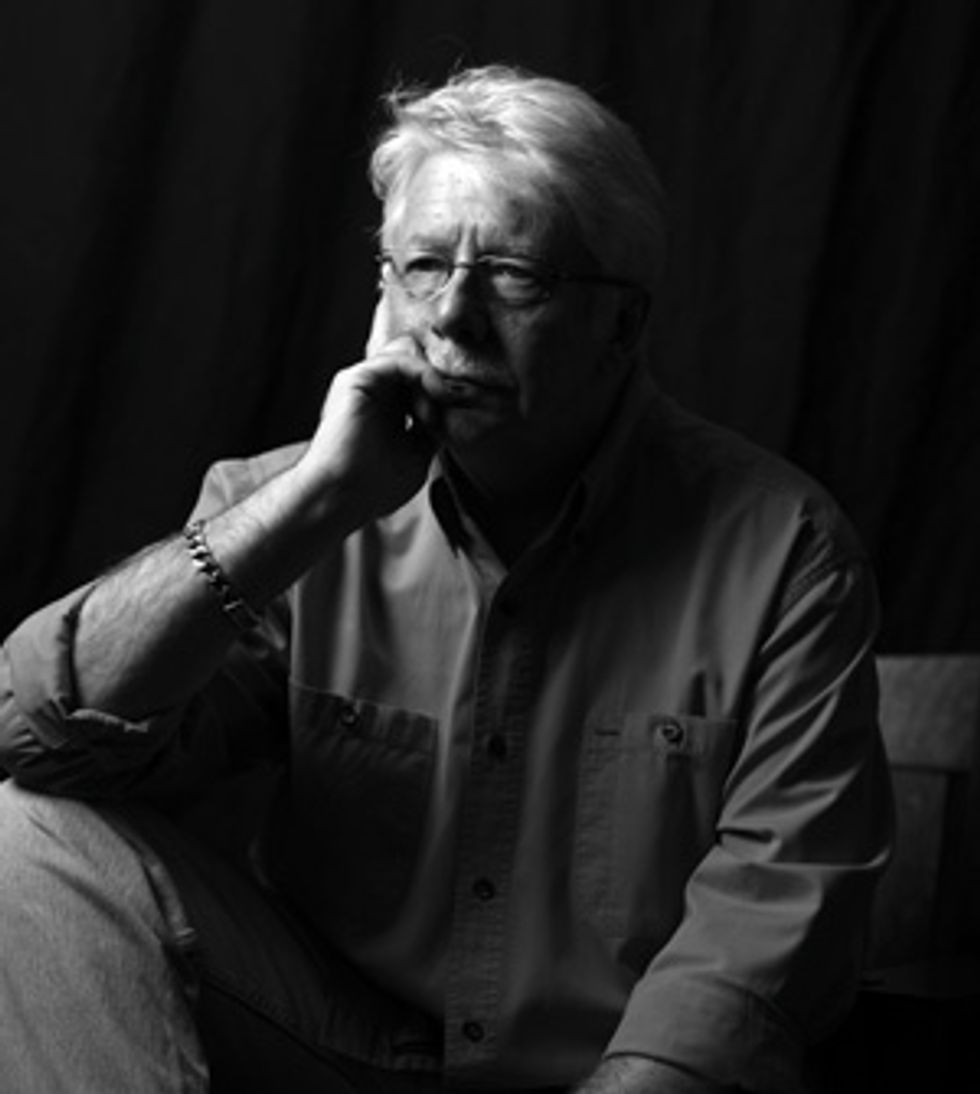
Legendary recording engineer and producer Ken Scott recently put pen to paper for the biography, Abbey Road to Ziggy Stardust.
1. Make decisions as you record. Don’t wait until mixdown. According to Scott, “No one likes to make a decision, and it’s not just in music—it’s in life it seems. Everyone is second-guessing themselves. How many times have you been to the supermarket and you’ll walk past a guy with a cell phone to his ear: ‘Yes, honey, I know, but there are 10 different kinds of baked beans. Which kind is it I’m supposed to get?’ It’s just baked beans, come on. So you make a mistake, she’s not going to kill you for it. Make a bloody decision!”
2. Listen to many different musical genres and try to learn as much as possible from each. Don’t be afraid to experiment. It’s nice to have a total picture of where you are headed, but leave the final destination open to improv and creative discretion.
3. Your idea of sound should be constantly changing. “That’s how you grow,” Scott says. “A band like The Beatles, they were changing constantly. As they learned more and more, they would make things change. They would take the audience with them, and that’s how they managed to come up with such incredible stuff—they were always learning and they always wanted something to be different.”
4. Make recordings with the gear you have. Great recordings can be made with any level of equipment if the sources and performances are great.
5. Invest in good monitors and learn how they sound. Everything starts with being able to hear your tracks accurately.
6. Play out live as much as possible and learn from the audiences’ response to your performance. You’re bound to benefit from being exposed to other perspectives.
7. Pare down performances to the essentials. Focus on making the best song, don’t fixate on the individual parts to the point of losing the forest for the trees.
8. Go into recording sessions with an end in mind. Don’t worry about having every detail mapped out, but a good arrangement and a vision for the final result will make for a much more productive and successful session.
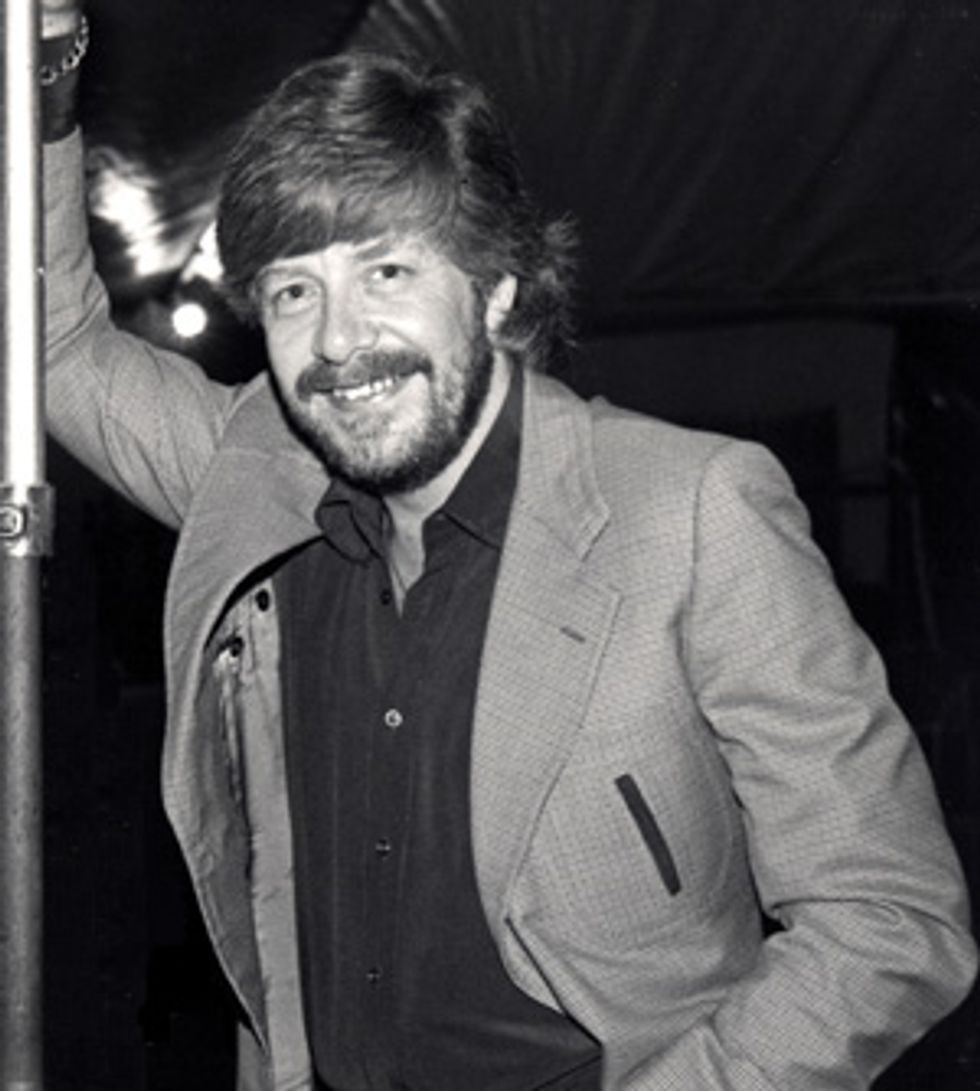
Ken Scott sports a managerial look, circa 1983. Photo courtesy of Ken Scott
Was that the same when you were
working with the Dixie Dregs? Steve
Morse composed all the parts in
advance, did he not?
Yeah, it was the same with the Dregs. The
first time I ever met them was in pre-production.
I walk in and they play their
first song, one called “Take It off the Top,”
and I stopped them in the middle and
immediately laid into the drummer [Rod
Morgenstein]. [Laughs.] He was just overplaying
so much, it was a constant battle
between him and everyone else. Steve was
trying to get as many notes in as possible,
the bass player was trying to get as many
notes in as possible, and Rod was trying
to get as many hits in as possible. We took
small sections of the song, and I just had
him pare it way down. He hated me. It’s a
great story between us, because he absolutely
detested me at that point because I was
stopping him from showing off. But once
he heard it starting to come together in the
studio, more as the song as opposed to their
individual pieces, then he suddenly realized
what I was getting at. He re-thought all of
his drum parts. He now says that thanks to
what I did that day, he still has a career.
I knew a little bit more about what had to happen—more than they did—right from that get-go. Once we’d laid down the basic tracks, then it was overdubbing. With Steve’s guitar, it was so sectionalized. One of the things that I loved working on with Supertramp was using as many different guitar sounds as we could get, and that’s what we did with Steve. It was, “Okay, we’ll take this verse … this part should be this kind of sound, this part should be this kind of sound.” We’d zero in on the sound, he’d play those parts, we’d double them or whatever, then we’d get the sound for the next part, and just patch it together like that. So, exactly what should the sounds be? I didn’t know up front. We had to find them.
It sounds like you need a well-developed
sense of psychology to work as a producer.
How do you read the musicians
and know how to handle them?
I have no idea! Take my history with Jeff
Beck. The first time I worked with Jeff,
it was to record the first Jeff Beck album,
Truth. It was a bunch of guys who weren’t
really known. Jeff had a bit of a reputation
from the Yardbirds, but certainly nowhere
near as big as Clapton was coming out of
that band. Little-known, generally regular
guys—they were a blast. They were really
fun to work with and they were really
good, obviously.
Then we complete the project. Album comes out, they tour the States, they come back to start on the next album. And the egos were through the roof! We couldn’t work together, it was obvious. I think we did one day and that was it—sessions got canceled because it just wasn’t working.
I don’t see Jeff for a while until I start to work with Stanley Clarke. Jeff comes in and plays on a couple of tracks on Stan’s albums, and he’s back to normal again—he’s a regular guy. It was really nice working with him again. No sign of that ego. Then I get to work with him again later on There and Back. It was the exact opposite of everything! He didn’t feel he was good enough to be playing with those musicians. On this occasion, I had to try and draw his performances out of him. I was sort of stroking his ego the whole time, “Jeff, you can do it, come on mate, this is easy for you.” That was very hard. I hadn’t had to deal with that before. That was a learning experience for me, trying to pull something out of an artist they didn’t think they were capable of. Generally, they go over the top. It’s easier to pare it down than it is to get it out of them.
You’ve done pop, glam, fusion, blues,
rock, new wave—all sorts of different
things. What drives you to work in new
musical styles?
I get bored. I used to drive my managers
crazy. Because they were getting a percentage,
they would like to book you up
as an engineer/producer for the next two,
three years, and know exactly what you’re
doing. I could never do that, I had to
wait until I finished a project and then
say, “Okay, bring me stuff.” Stuff would
come in, “No, no, I just did something
like that.” It was just trying to find
something I felt like doing. Although,
the weird thing is, I am a total creature
of habit. Recording drums, I can literally
set up the EQ before the kit is even in
there. With guitars, I always mic exactly
the same way. But musically, as a producer,
I need it to be different every time.
What is your approach to mic’ing an
electric guitar?
A Neumann U 87 about 18" away and
whatever you want for a distant mic.
How far away is the distant mic?
No specific distance.
Do you “tune” the placement by ear?
Yes.
Do you aim the close mic at the speaker
cone, the center of the speaker, or
another spot?
No. Actually, I just put it where it looks
right! [Laughs.]
Do you fine-tune it from there or just
set it and go?
Just set it and go, generally speaking.
Obviously, there are times that you try
different things. There was a track on the
Devo album, Duty Now for the Future,
where we wanted a very small, distorted
sound. We messed around trying to get
it, and we finished up taping some headphones
to a Neumann U 87. That gave
us a really small sound and it was exactly
what we were looking for.
So there are times that you modify it, of course. But generally, 90 percent of the time it would just be the U 87, set it in front, and that’s it.
Given your approach, it must be
essential to get the sound right at the
source—at the amp.
It’s always from the source, from the
performance to the sound. That’s one
of the things with the way we were back
in the day. Because we had so little EQ,
so few effects, the sound had to start in
the studio. I’m a firm proponent of the
performance has to come from the studio.
It really annoys me, all of the stories about
someone will do something and it’s, “Yeah,
that’s okay, we can just put it all together
in the computer.” No, get them to bloody
sing it right in the first place! Don’t use
Auto-Tune, don’t move everything around
so it’s on the grid. You’ve got to get the
performance. That’s the thing with Bowie’s
vocals. No, they’re not perfect. There are
places where they’re not quite in tune nor
in time. But they’re from his heart, they’re
from his soul. They’re performances. That’s
why, 40 years down the line, we’re still talking
about them.
Simple is Better
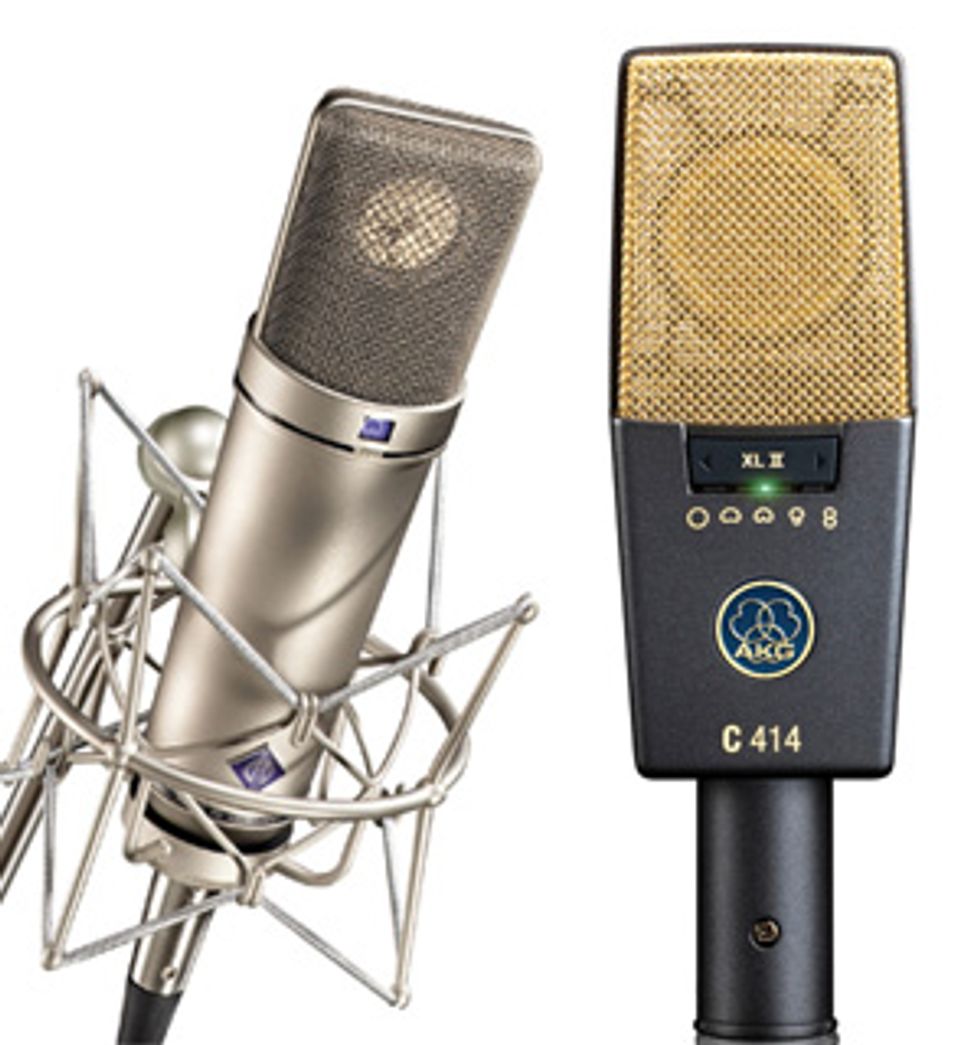
Left: Neumann U 87. Right: AKG C414.
Ken Scott calls himself a “creature of habit” when it comes to recording—he trusts specific techniques and gear. For electric guitar, he relies on a Neumann U 87 microphone, placed 18" in front of the speaker, plus a “distant” mic, placed farther away from the speaker. The type of microphone used for the distant mic isn’t critical, though the polar pattern will make a big difference. A cardioid mic will be more directional and pick up less room, a figure-8 mic will capture more room sound, and an omnidirectional mic will capture the most room.
Scott works to get the sound right at the source—at the amplifier—then captures it with his straight-ahead mic’ing techniques.
For acoustic guitar, a single condenser microphone—in Scott’s case, an AKG C414—is placed near the body, looking at the soundhole or bridge. The mic is adjusted by ear to find the ideal location.
If you don’t have access to these higher-end microphones (a basic Neumann U 87 costs approximately $3,200 and the AKG C414 is around $1,000), try using another largediaphragm cardioid condenser microphone. During his days recording The Beatles at Abbey Road, Scott often relied on an inexpensive AKG D19C condenser microphone for acoustic guitar, piano, drums, and many other sources. Today there are many large-diaphragm condensers on the market to choose from. Some affordable substitutes include the Behringer C-1 ($44), Samson C01 ($80), AKG Perception 120 ($99), Audio-Technica 2035 ($150), Studio Projects B3 ($160), Shure PG42 ($200), Rode NT1a ($230), and Mojave Audio MA-201 ($695).
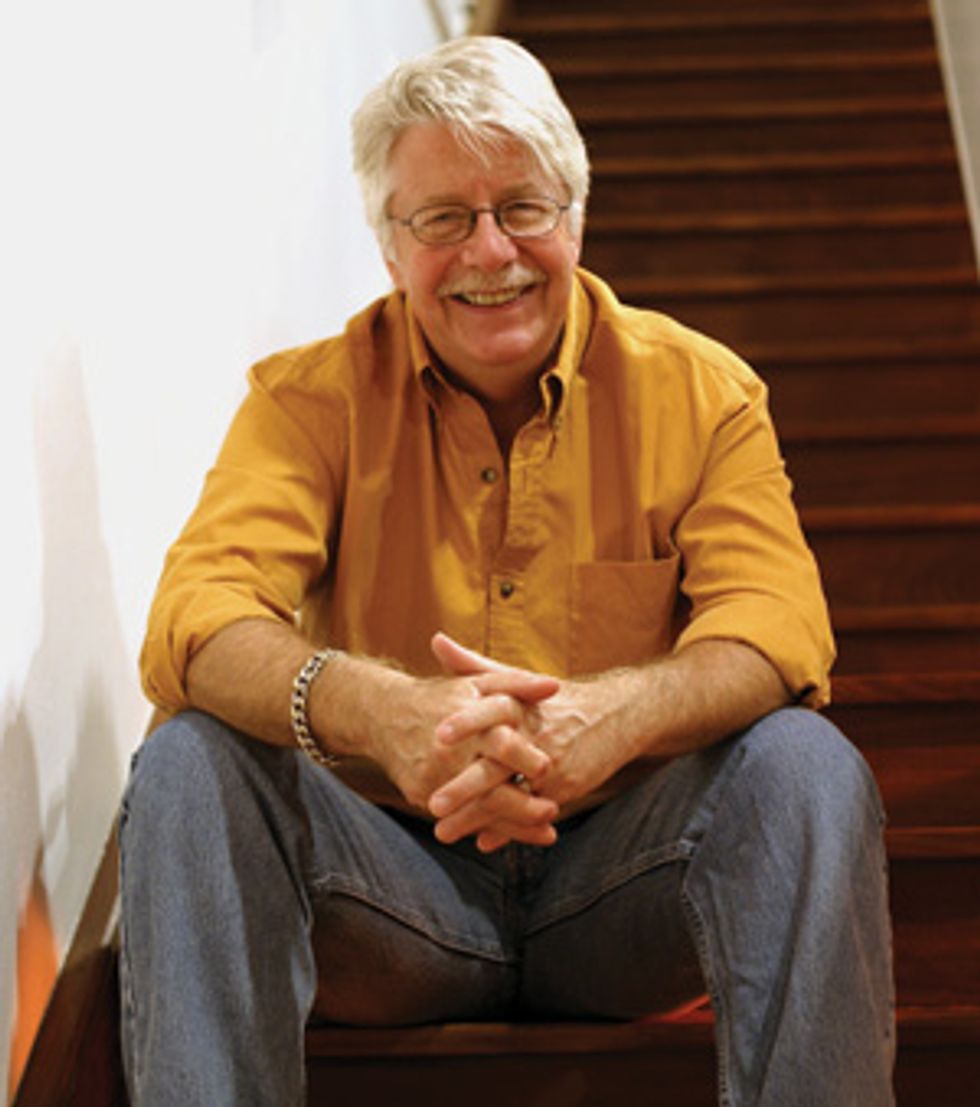
Ken Scott recommends making recording decisions early in the studio, on the spot, rather than waiting until later. Photo courtesy of EMI Archives
How much do you feel that preamps
and other gear factor into the sound
that you get?
From my standpoint, very little. I’ve worked
in so many different studios and they’re
all different. For me, the most important
part of a studio—and the thing that has to
be right in the studio, there’s no two ways
about it—is the monitor system. Because if
the monitors aren’t right, then you have no
idea what you’re doing. You’re not listening
to the true sound. How do you work
with the sound if you don’t know that what
you’re listening to is right?
I put it that way—as being “right”— because we all like to hear things slightly differently. You get to know what you like to hear. You hear that inside the studio and outside the studio. Wherever you listen, you’re listening for a particular kind of sound.
How important is the actual recording
space that the amplifier or speaker is in?
It’s not. You work with what you’ve got.
As far as guitars go, I don’t think it makes
that much difference. There are times that
I’d love to have a guitarist in a big hall so
you can get all of that amazing reverb from
the distant mic. But generally speaking, it
doesn’t matter… [Pauses.]
I suddenly realized as I’m saying this, to a point I’m wrong! [Laughs.] There’s an example with Mahavishnu Orchestra where we started recording at Trident [Studios in England], and everything went great. This was Birds of Fire and we didn’t have enough time to do the entire album, so we came over to finish it off in the States. We were booked into Criteria, down in Florida. John [McLaughlin] immediately blew up two 100-watt Marshalls. What it was, the room was so dead. It was that time with the Bee Gees and disco, and the sound was very, very dead. John couldn’t get the sound out of his amp without blowing it up. Everything was turned full bore and it just sounded quiet. Everything was being sucked up. We finished up canceling the sessions and moving to [NYC studio] Electric Lady, which worked great. So that’s an example where, yeah, the room can affect everything.
What’s your recording process?
It depends on the musicians and the
music. With Missing Persons, because
Terry was one of the main writers, he
knew exactly what needed to happen
from the very beginning. Terry wanted
it to appear that the drums were pulling
everything along. He wanted to be ahead
of everyone the entire time. So the way
we worked with him was, it was just him
playing, no one else, no guide tracks or
anything. He just played the track. Once
we got a drum track that really swung,
that felt great, we knew we’d gotten the
basis for the track. Then we started to
overdub things. I felt so sorry for Patrick
O’Hearn, the bass player, because we’d
be doing a take and so often it was just
eighth-notes and Terry would be, “No,
no, no! You’ve got to hold back a bit. I’m
pushing, I’m pushing!” It was so minute
and Patrick was going through hell, but
it all worked in the end.
So in that instance, it was just drums. Other times, it’s bass and drums, just going for those. There are obviously times where I’ve gone for guitars, bass, and drums. And then I’ve overdubbed from there. It depends.
You’ve said that the best way to learn
to record is to limit yourself to 4-track
equipment.
Absolutely! It’s the thing of making decisions.
Because that’s something that, for
me, is missing these days. No one likes
to make a decision. That’s why albums
are taking three years now. They’ll record
something: “Tell you what, I don’t think
it will work, but let’s keep it until the
mix and make the decision then.” So
you finish up with 199 almost useless
tracks and you’re going to decide at the
end as to whether they work or not. It
makes mixing horrendous. Just make the
bloody decision up front. Have an idea
of the final product and make the decision
during the takes.
I always used to do it. We’d be going through, “No, that’s not the take,” and go back and erase it. I’d record over it and keep on doing it. The decision was made then and there: “Yes, that’s the take, we’ll keep it.” That’s why I would love engineers and producers to spend some time working on 4-track because obviously you have to make decisions.
Are you committing to compression
and EQ as it goes down?
Oh yeah, do it right. I like to hear the
record as we’re putting it together, the
final thing.
When it comes time to mix, you’re basically
able to push the faders up and then
just be creative with what you want to
do with the mix. You don’t have to worry
about making the tracks work.
Yes, absolutely. You already know it
works to 75-percent certainty, and it’s
just zeroing in on the other 25 percent
to make it magic.
Do you have a specific approach to
recording acoustic guitar?
My normal way of doing it would probably
be an AKG C414. I do it really
close, it’s angled at the hole or it’s angled
more toward the bridge end. I’ve found
that acoustic guitars are a little touchy.
You have to do more with the mic and
the mic placement with an acoustic guitar.
So I will experiment more with an
acoustic guitar, trying things.
Have you found any modern microphones
that are useful to you?
No—but there are always exceptions to
the rule. When I did Missing Persons,
the first set of recordings that I did with
them—which were originally supposed
to be demos, and they finished up being
amongst their most popular songs—we
went into Frank Zappa’s studio to record.
Frank had just had that studio built. He
was on the road and he wanted to come
straight back in and start working in the
studio. He knew my reputation for finding
every possible fault that there is in
a studio, so he allowed us to have it for
free knowing that I would find all the
faults and get them fixed before he came
back off the road. The problem was
that all of his best mics, which were the
ones that I would normally use, he had
on the road because he recorded every
single performance. So we had to work
with his sort of “B” mics. When you hear
the album, there’s a mix of some of those
tracks that we did there with the “B” mics
and the rest of the stuff I did at my regular
studio with the “A” mics and you can’t hear
the difference!
As I say, it’s down to the monitors,
because if you know what you’re listening
to, you can adjust to anything.
For someone who’s working at home
and they’re trying to do a professional sounding
recording, do you recommend
that they go rent some of those A-list
microphones or should they try to get the
sounds with microphones they can afford?
No, try and get the sounds with the microphones
they can afford. But make sure that
what they’re listening to is good.
So put the money in the monitors.
Yes, absolutely, every time.
How can an artist keep their creative
spark and be willing to take chances?
You have to make music for yourself, to
make you happy. You can’t make it to have
a hit. Too many acts these days, they’re
out there to get a record deal or to make
money or to become famous. The Beatles
never started that way, The Who never
started that way. Jeff Beck never started
that way. They started because they wanted
to make music. U2—the same. They
made music because they enjoyed making
music, and people started to like it. That’s
the way to do it.
If you’re doing it purely to make money, you’re never going to be happy. Because more often than not, you’re not going to make that money! If you’re making it to please yourself, at least you’ve always pleased yourself. If other people like it, that’s the icing on the cake.
The other thing is, play out live as much as possible. You learn your gig from the audience, from what they give back to you. You don’t learn your gig in the garage, rehearsing, rehearsing, and rehearsing. You don’t get to know what people think of what you’re trying to do.
Any other tips for capturing great guitar
recordings beyond what we’ve talked
about?
It needs to come from the guitarist in the
first place. If you take Mick Ronson, his
sounds were always unique. He’d get his
tone by going through a wah-wah, finding
the place where we all liked the sound and
then leaving the wah-wah there. You find
your own techniques to get what you want
across. It’s just a question of experimenting
and finding what works for you.



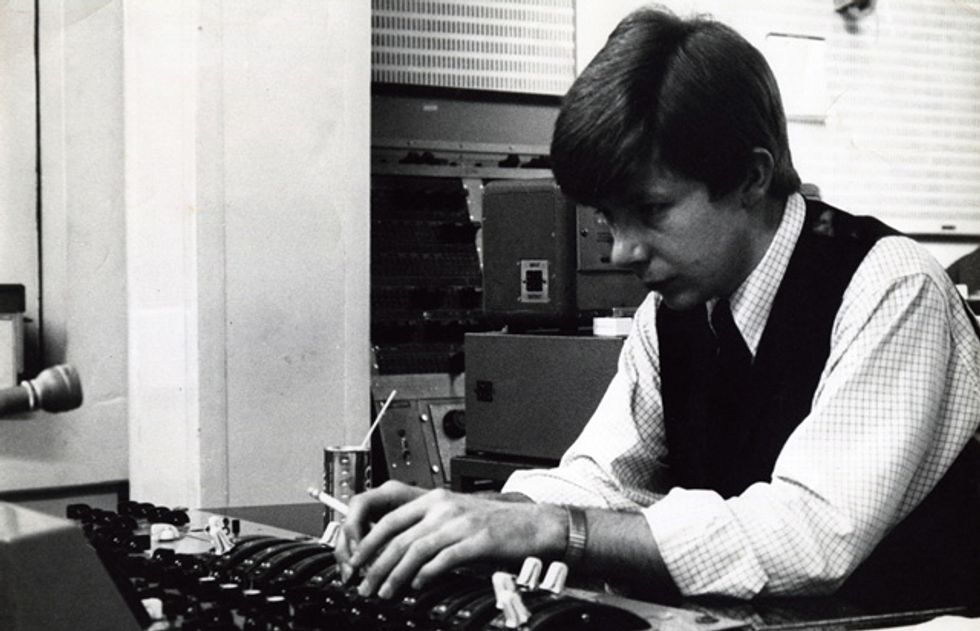
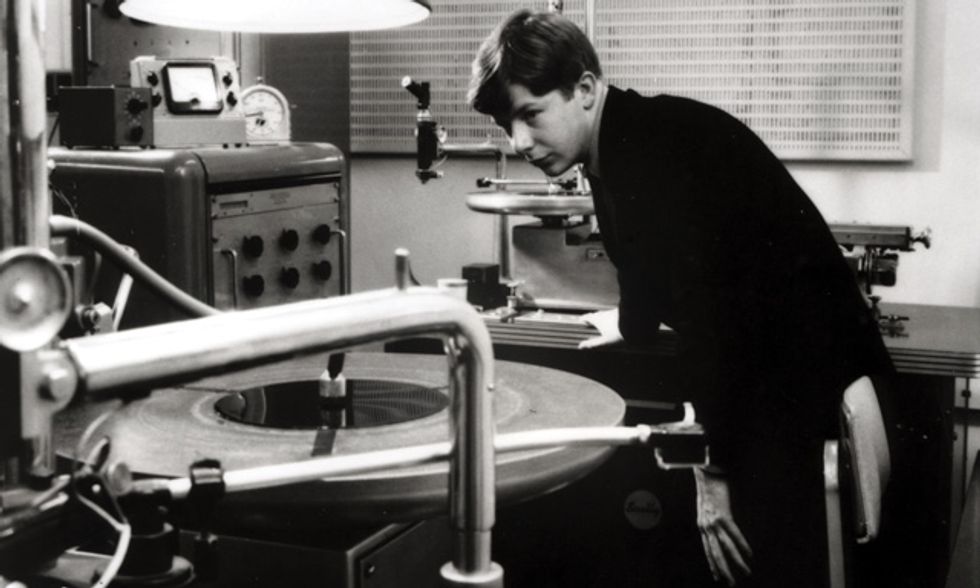







![Rig Rundown: Russian Circles’ Mike Sullivan [2025]](https://www.premierguitar.com/media-library/youtube.jpg?id=62303631&width=1245&height=700&quality=70&coordinates=0%2C0%2C0%2C0)













![Rig Rundown: AFI [2025]](https://www.premierguitar.com/media-library/youtube.jpg?id=62064741&width=1245&height=700&quality=70&coordinates=0%2C0%2C0%2C0)




















 Zach loves his Sovtek Mig 60 head, which he plays through a cab he built himself at a pipe-organ shop in Denver. Every glue joint is lined with thin leather for maximum air tightness, and it’s stocked with Celestion G12M Greenback speakers.
Zach loves his Sovtek Mig 60 head, which he plays through a cab he built himself at a pipe-organ shop in Denver. Every glue joint is lined with thin leather for maximum air tightness, and it’s stocked with Celestion G12M Greenback speakers.











